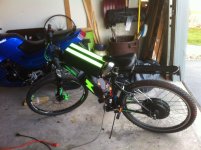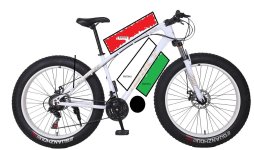Well, I sold the motorcycle and now I only have my 500W 1.2kWh ebike, which is great and fun but a bit too slow at 22-23 mph top speed, 17 mph cruise, 50 mile+ range. I want to go a bit faster so 40-45 mph top speed, 30 mph cruise, and still 50 miles+ range (at 25-30 mph). I am on a tight budget and maybe some of these requirements can be flexible.
Also, I like to stick with the scooter pack batteries 36V 4.4aH 20A max cont, 35A peak. I mean I don't trust these batteries to do 35A peak so lets just say 20A is peak and I will try to stay around 15A or lower. I have 36V 32aH at the moment.
Here is what I am thinking in terms of a budget build options. Also, I cannot afford the 3000W+ rear hub wheels.
A. Fat tire bike - 3000W SBP Cyclone mid drive kit, iBiky 26" fat tire bike, 72V 24-26aH battery (scooter packs in series). This will cost me about $700. I like this build because there is a free wheel on the mid drive which will allow me to bike without cogging (magnet resistance). However, the issue here is since the batteries are not great I am limited to 20A max which is ~1500W with maybe 2000W burst. Will the bike still be able to get up to 40mph with this limit and a light rider with a windshield. I know 1000W gets you to 30mph but its not linear to 40mph.
B. Scrap fat bike - 1500W rear hub kit, 36V 50-52aH, 1500W step up converter (36V into 52V), new Schalbe Marathon tires, and existing 26" mountain bike. This will cost me about $450. It wont take me to 40mph maybe in a tuck but I should be able to maintain a 30mph cruise. Also, there will be cogging from the magnets and since the step up max is 1500W and the motor probably peaks 2000W I wont get that peak power for 40mph?
C. Super budget - 1000W rear hub kit, 36V 50-52aH, 1500W step up converter, new Schalbe Marathon tires, and existing mountain bike. This will cost me $400. Max speed will be 30 mph but I should be able to use full conversion on the 1500W step up converter.
Yeah, I dunno. The biggest concern with best option fat tire bike and cyclone mid drive is the battery wont be strong enough to utilize full power of the engine, which probably peaks at 4000W. So, it might just be a waste. I really like the look of fat tire bikes. It has such a wow factor.
Here is my current bike, the proposed fat bike look (modeled after Ducati Panigale italian flag decals), and a video of some fun on fat tire ebikes.
https://www.youtube.com/watch?v=OMwk2ttirGA
Also, I like to stick with the scooter pack batteries 36V 4.4aH 20A max cont, 35A peak. I mean I don't trust these batteries to do 35A peak so lets just say 20A is peak and I will try to stay around 15A or lower. I have 36V 32aH at the moment.
Here is what I am thinking in terms of a budget build options. Also, I cannot afford the 3000W+ rear hub wheels.
A. Fat tire bike - 3000W SBP Cyclone mid drive kit, iBiky 26" fat tire bike, 72V 24-26aH battery (scooter packs in series). This will cost me about $700. I like this build because there is a free wheel on the mid drive which will allow me to bike without cogging (magnet resistance). However, the issue here is since the batteries are not great I am limited to 20A max which is ~1500W with maybe 2000W burst. Will the bike still be able to get up to 40mph with this limit and a light rider with a windshield. I know 1000W gets you to 30mph but its not linear to 40mph.
B. Scrap fat bike - 1500W rear hub kit, 36V 50-52aH, 1500W step up converter (36V into 52V), new Schalbe Marathon tires, and existing 26" mountain bike. This will cost me about $450. It wont take me to 40mph maybe in a tuck but I should be able to maintain a 30mph cruise. Also, there will be cogging from the magnets and since the step up max is 1500W and the motor probably peaks 2000W I wont get that peak power for 40mph?
C. Super budget - 1000W rear hub kit, 36V 50-52aH, 1500W step up converter, new Schalbe Marathon tires, and existing mountain bike. This will cost me $400. Max speed will be 30 mph but I should be able to use full conversion on the 1500W step up converter.
Yeah, I dunno. The biggest concern with best option fat tire bike and cyclone mid drive is the battery wont be strong enough to utilize full power of the engine, which probably peaks at 4000W. So, it might just be a waste. I really like the look of fat tire bikes. It has such a wow factor.
Here is my current bike, the proposed fat bike look (modeled after Ducati Panigale italian flag decals), and a video of some fun on fat tire ebikes.
https://www.youtube.com/watch?v=OMwk2ttirGA



